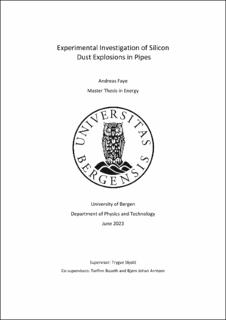Experimental Investigation of Silicon Dust Explosions in Pipes
Master thesis
Permanent lenke
https://hdl.handle.net/11250/3077004Utgivelsesdato
2023-06-01Metadata
Vis full innførselSamlinger
- Master theses [123]
Sammendrag
Metallurgical silicon and its alloys are essential in several industries, such as solar energy, automotive, aerospace, and steel production. However, silicon dust, generated during silicon production, processing, and handling, poses significant health and safety hazards. Dust extraction systems control these risks by capturing, transporting, and removing dust particles from the work environment, thereby improving air quality for personnel, and reducing the accumulation of dust deposits. This study investigates the hazards associated with dust explosions in dust extraction ducts. It measures explosion pressures inside pipes and observes the length of emitted fireballs. Experiments were conducted using an explosion vessel and pipes of three different internal diameters, with expanders and reducers utilized to create pipe configurations of both diminishing and increasing diameters, simulating a small-scale dust extraction system. The dusts used in the experiments were silicon and silicon-alloy dusts, with dust layers representing nominal dust concentrations ranging from 250 to 5000 g/m³. Piezoelectric pressure transducers recorded pressure development at specific locations inside the pipes, while a high-speed camera captured the fireball length emitted from the pipe ends. Experiments involving single pipes and configurations of two connected pipes revealed a strong correlation between dust layer concentration and fireball length. However, no evidence suggested a relationship between explosion pressure and dust layer concentration. A 25-metre configuration with four connected pipes of varying diameters, with the smallest pipes near the exit, demonstrated that silicon dust, formally classified as St-1 dust, although on the limit to St-2, can result in detonation-like overpressures and shock wave speeds. Further research is needed to determine whether and under which conditions a silicon dust deflagration may transition into a self-sustained detonation.
